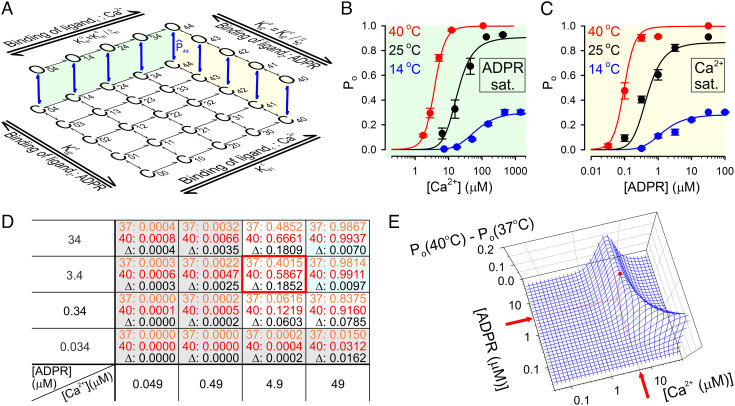Fig. 4.
Temperature threshold of TRPM2 is optimized for physiological [ADPR] but supraphysiological [Ca2+]. A, Simplified model of TRPM2 gating by Ca2+ and ADPR; open states O00… O33 are omitted for clarity. Green and yellow shadings highlight the subschemes that describe gating in saturating ADPR and saturating Ca2+, respectively. , closed–open equilibrium constant of fully liganded TRPM2; ξ1 and ξ2, coupling constants of the two agonists; and , dissociation constants of Ca2+ from closed and open channels, respectively; and , dissociation constants of ADPR from closed and open channels, respectively. (By the principle of detailed balance and ). B, C, TRPM2 open probability in (B) various [Ca2+] plus saturating ADPR and (C) various ADPR plus saturating [Ca2+] at 14°C (red symbols), 25°C (black symbols), and 40°C (blue symbols). Colored curves represent ensemble fit of the scheme in panel A to the entire data set using four free parameters (see text for details); the fitted values are ΔH044 = +202 kJ/mol, ΔS044 = +696 Jmol−1K−1, = 16.6 μM, and = 0.35 μM. D, Po values calculated from the fitted model for a range of [Ca2+] and [ADPR] at 37°C (orange numbers) and 40°C (red numbers), and ΔPo = Po(40°C) − Po(37°C) (black numbers). The red frame marks the maximum point for ΔPo, and shaded cells identify agonist concentration ranges in which Po is ~0 (gray) or ~1 (cyan) at both temperatures. E, Three-dimensional mesh plot of ΔPo as a function of [Ca2+] and [ADPR]; the red dot identifies the maximum point.

